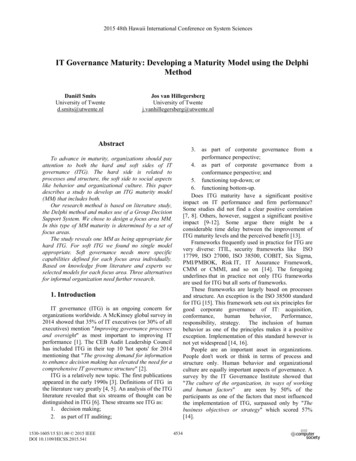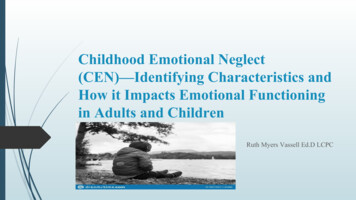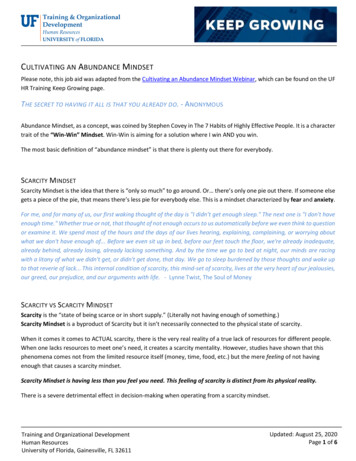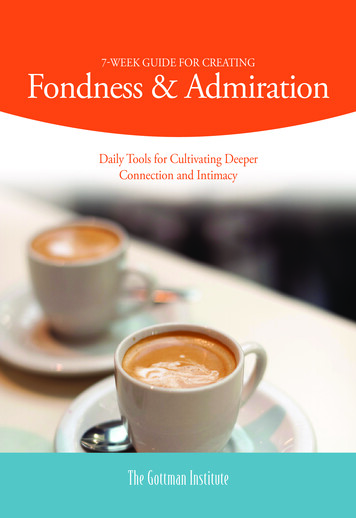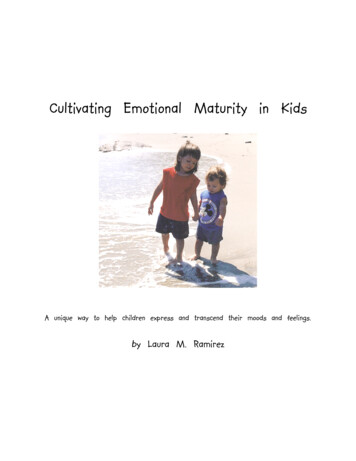
Transcription
Cultivating Emotional Maturity in KidsA unique way to help children express and transcend their moods and feelings.by Laura M. Ramirez
Cultivating Emotional Maturity in Children 2Walk in Peace ProductionsPOB 12396Reno NV 89510-2396Copyright „ 2005 by Laura M. Ramirez. All rights reserved. This work is the soleproperty of the author and may not be copied, stored in a retrieval system ordistributed electronically or in any other form without the express written consent ofthe author. Violators will be prosecuted to the full extent of the law.Disclaimer: The information in this special report is opinion only and should not beconstrued as professional advice. If advice is needed, consult a professional. Theauthor and publishing company assume no responsibility for the opinions mCopyright 2004 by Laura M. Ramirez
Cultivating Emotional Maturity in Children 3Cultivating Emotional Maturity in ChildrenIn my book, Keepers of the Children: Native American Wisdom and Parenting, Iemphasize the idea that parenting is about guiding a child to grow into a mature adult. Thinkabout this for a moment because it is an important concept.During your lifetime, you have probably encountered many “adults” who looked likegrown-ups, but didn’t act like them, especially when faced with stress. These are the babies ofthe adult world—those adults who pout, rant, blame, and shame their way through life.Whenever things don’t go their way, you can count on them to throw a tantrum. This is becausetheir perspective is limited to themselves.Emotional intelligence is essential to creating a fulfilling life because it is the hallmark ofa mature adult. According to Daniel Goleman author of Emotional Intelligence, “Emotionalintelligence is the capacity for recognizing our own feelings and those of others. It assists us tomotivate ourselves and manage emotions well in our relationships. Our emotional quotientcontributes to our ability to create trust, build productive relationships and demonstrate theresilience to perform under pressure.”Now that you know what emotional intelligence is, let’s take a look at what it isn’t byexamining a real life story. This will give you a glimpse of how essential emotional intelligenceis to an adult’s ability to act maturely. In fact, this is how I have illustrated its importance to myboys.A couple of years ago, my eldest son was in a little league playoff game. My husband,Larry, was the pitching coach for our team. (Unlike many little league coaches, my husband hasa great deal of expertise in pitching and was recently inducted into the American Indian AthleticHall of Fame for leading his team to win the College World Series back in 1970.) On the otherteam was a coach whom we’ll call Fred who had his son (whom we’ll call Chase) on his team.When the game began, Chase was pitching. During the first inning, a boy on our team namedJessie came up to bat. Chase pitched the ball and Jessie, who was tall, but only seven-years old atthe time, whacked the ball straight back at him. The ball hit Chase’s fingers and he began to cry.His mother ran to get some ice and after a few minutes of comfort from his parents, Chaserecovered enough to finish off the t 2004 by Laura M. Ramirez
Cultivating Emotional Maturity in Children 4Three innings later, the positions were reversed. This time Jesse was pitching and Chasewas up to bat. Since this was an instructional league, my husband, Larry, stood behind Jessie onthe mound to coach him as he pitched. When Jessie hurled the pitch, Chase turned and it struckhim on the shoulder. He tore off his baseball helmet, threw it to the ground, stamped his feet andbegan to shriek. Fred, who was coaching third base, ran to Chase’s aid. After he comforted himfor a moment, he turned, pointed at Jessie and snarled, “That makes two!” Jessie flinched. Myhusband said, “Fred, it was an accident. No one was trying to hurt your son.” Fred glared at myhusband, clenched his fists and charged the mound. Fearing that Fred was going to slug him,Jessie shrank back against my husband and began to cry. The other coaches hurried toward themound to prevent Fred from hitting Jessie or my husband. (My husband is handicapped and mustwear leg braces and use a crutch to stand, so naturally the other coaches wanted to restrain Fred.)While the other coaches held Fred back , he screamed obscenities at my husband anddemanded that he get off the field. From my perspective in the stands, Fred’s behavior seemedpsychotic. Here was this fifty-something year old man—a coach and role model—whose blindrage was terrifying the kids. Even his son was crying.Later, when discussing this incident with my boys (who were eight and six at the time), Isaid, “This is why we are teaching you to be mature, so you don’t become a man like Fred.” Wetalked more about Fred’s behavior. I said, “A fifty-seven year old throwing a tantrum on a littleleague field—not a pretty picture, is it?” The boys solemnly agreed.To underscore Fred’s irrational behavior, we talked about the realities of little leaguebaseball. Sometimes in baseball, kids get hurt. When a seven-year old is learning how to pitch,he’s bound to hit someone, not because he intends to, but because he doesn’t have control of theball. As a coach, Fred should have known this, but instead, he chose to turn an accident into aconspiracy.Let Fred serve as a reminder for us all. In order for children to grow into emotionallymature adults, they need practice, guidance and role models who show them how to act maturelyin a variety of situations. Like everything in life, emotional intelligence is a skill that can bemastered but only with a firm and loving guide. Obviously, Fred did not have such a teacher.Unfortunately, it looks like Chase won’t t 2004 by Laura M. Ramirez
Cultivating Emotional Maturity in Children 5The first step in teaching children to master their emotions is showing them compassion.Compassion is essential because it creates perspective. Had Fred had compassion for someoneother than himself, he would have had no need to throw a tantrum.Teaching CompassionA parent models compassion by being compassionate. The word compassion comes fromthe Latin compassio, which means “to suffer with.” When you have compassion for someone,you empathize with what they are going through. All children need a compassionate witness tohelp them feel that they aren’t alone.A simple example of compassion is when a child falls down and hurts herself and themother holds the child and comforts her, saying something like: “Ooh that must have hurt.”Identifying the hurt confirms the child’s reality and comforts her in a time of need.By contrast, there are some parents whose answer to a crying child is to brush her aside,saying things like, “That didn’t hurt” or “Don’t be a baby.” Although such parents believe thatthey are preparing their child for reality by toughening her up, they are denying the child’sfeelings. When a parent denies a child’s reality, the child denies herself.Since you can guarantee that your child will receive her ‘hard knocks’ from the world,she should be able to count on you for comfort which she will seldom get outside the home.When your child is ready, she will stop coming to you for every scrape and bruise because shewill have learned through your example how to soothe herself. If you give your child compassionfor the small scrapes of life, she will know that she can trust you with the bigger things.Being compassionate starts with helping your child understand that there’s nothing wrongwith having feelings. At one time or another, each of us has felt love, hate, jealousy, apathy,anger, rage, despair, etc. Having such feelings does not make us bad—it simply means we’rehuman. As Alan Harrington says in his book, Psychopaths, the difference between the saint andpsychopath are not their thoughts, but what they do with them. Although a saint mayoccasionally entertain the murderous thoughts of a psychopath, what makes him different is thathe doesn’t act on them because he sees a greater reality.In the same way that we’ve all had similar thoughts and feelings, we also have aspectrum of moods: happiness, elation, hopelessness, despair, etc. While a mood refers to anatmosphere or tone, like a feeling, it is temporary. If we teach our children how to recognize andwww.parenting-child-development.comCopyright 2004 by Laura M. Ramirez
Cultivating Emotional Maturity in Children 6transcend these states of mind, we show them how to make choices that arise from a biggerperspective. If we make our children feel bad about their moods, they will either identify withthem or deny themselves the experience of being a sentient human being.To feel compassion for your child, recall your childhood moods. For easy identification,it helps to make moods into characters. Follow along with me and I’ll show you how toacknowledge and gently tease your children from the moods that do not serve them. The firststep is to create some snapshots of common childhood moods. When you picture yourself as achild, what images come to mind?When I picture myself, I see a blonde girl in a pink striped dress, white knee socks andblack, patent leather shoes, giggling, twirling and glancing back, teasing, as she half runs, halfdances across the lawn. I have a name for this girl I call her Glee.Glee represents the freedom, joy and spontaneity of childhood. Hopefully, every parenthas known her or her male equivalent. If you haven’t known her or if you’ve known her onlyrarely, seeing children in the throes of Glee might make you feel anxious, angry or resentful.This is why certain adults have little tolerance for squeals of delight and wiggly, giggly behavior:they’ve denied their sense of Glee.Although this might seem like a silly exercise, Glee is real – she exists physically andemotionally in a space in time. Her energy is palpable and transformative. You can see her inyour child. Next time you see her, acknowledge her with a smile.When you smile in recognition, you’re identifying with and reflecting your child’sexperience of this feeling. The ability to mirror what another feels is another way we showcompassion.Although you might find Glee refreshing, there are many other characters that aren’tnearly as charming or delightful. For instance, remember Patti Pout? If I close my eyes, I can seeher clearly. Her drama-queen proclivities have tied her into a knot—her arms are crossed, hereyebrows drawn together and her lips pulled into a frown.Patti Pout is pouting because she’s not getting what she wants. Although she is blessedwith many things, she’s focused on the one thing that she can’t have. Patti is angry becausealthough she’s whined and thrown a tantrum, her parents haven’t given in this time.www.parenting-child-development.comCopyright 2004 by Laura M. Ramirez
Cultivating Emotional Maturity in Children 7Although Patti Pout might seem petty and self-entitled, she’s a valid childhood character.Rather than making your child feel ashamed of acting out Patti’s thoughts, you’ll learn how tohelp her make the choices that will progressively disentangle her from Patti’s clutches.I could go on and on about the characters of my youth. There’s Nancy Know-It-All andDebbie Defiant. There’s Silly Susie, Lisa Liar, Fearful Fran and Evie Everybody-Hates-Me.There’s Sandy Snitch, Jealous Jane and Just-Plain-Mean Maureen. There’s Sticky-Fingers Sue,Tammy Two-Face and Kay Chameleon. Each character is real in the sense that she shows acertain face to the world and exhibits a particular behavior. Every character is unreal in the sensethat she lacks dimension. She is a caricature, who plays a one-note mood, rather than a personwith dimension. Each character is a facet of the human norms that your child can learn torecognize and transcend.Although witnessing your child in the grips of Lisa Liar, Patti Pout or Tina Tantrummight seem tiresome, the experience can be made bearable by acknowledging that these moodsare universal and if you approach them properly, they will eventually lose their power over yourchild.With time and practice, children can begin to see that they are not their moods. You canteach them this, not in abstract way, but experientially—by helping them to identify the characterof each mood as it presents itself, acts out its performance and exits the stage.If you make your child feel bad for expressing a certain mood, there’s a danger that shewill identify with it permanently. We all know adults whose identity revolves primarily around acaricature like Mean Maureen or Nancy Know-It-All. Often, this identification begins in youth.If you attach connotations to your child’s moods, then she’ll confuse herself with thelabel. Some parents tell their children that they’re bad when they act out, while other parentsmake the distinction between bad behavior and the child.It doesn’t matter whether you make this distinction because a young child is unable toseparate his concept of self from the label you assign. To a child, bad behavior is evidence thathe is bad. If he continues to be identified as such, he will assume the label permanently. He willaccept your estimation of him and become or come to be like the label you’ve attached.Remember that while a mature adult possesses moods, a child is possessed by them. This is astriking right 2004 by Laura M. Ramirez
Cultivating Emotional Maturity in Children 8The key to helping kids rise above their moods is helping them express, recognize and letthem go. Obviously, this requires a certain level of consciousness. Since children are in theprocess of becoming conscious, this is a skill that must be developed with your help.What I’m suggesting is that rather than attaching labels to behavior, we can identifymoods with love and humor by using character names. This identifies the mood at the child’slevel of comprehension and defines behavior in terms of action, rather than character. (In mybook, character assassination is child abuse.) By doing so, you expose the mood for what it is: aflat caricature with limited choices. Each choice has a consequence. Show your child why acharacter’s choices are not resourceful and you’ll illustrate why choosing to rise above it is bestfor him and everyone involved.For instance, when my eldest son, Dakotah, was four years old, he had a tendency to takeon a depressive, everything-is-grim-and-gloomy mood. Since Dakotah was only four and Ineeded a way to show him how he was behaving at a level he could understand, I used theWinnie-the-Pooh character, Eeyore, as my translator.For those of you who are unfamiliar with Eeyore, he is a depressive character whoconstantly expects the worst. Since he has expectations that he doesn’t make known to others, hesets himself up for disappointment. To give you a mental image of Eeyore, I’ll give you one usedby his creator, A. A. Milne—Eeyore is the kind of character who opens an umbrella on a sunnyday because even though there’s not a cloud in the sky, he’s expecting rain.When Dakotah would sink into one of his Eeyore funks, I’d allow its full articulation.Sometimes that was all it took. If he continued on or tried to use the Eeyore mood to manipulateme for personal gain, I’d reflect his pout back at him and groan quietly in my best Eeyore voice,“It’s a gloomy, doomy day.” Sometimes, he’d glare at me and snap: “Be quiet!” (Few people likeit when their unsavory mood is reflected back at them.) Although my recognition of his moodinitially made him angry, I’d see the corners of his mouth twitch upward against the gravity ofhis frown. (This was an outward indication of the inner struggle between Dakotah and the Eeyoremood.)When you use this technique, be careful with your tone. Like any tool, it can be used toenlighten or shame and punish. The tool is less important than how it is used. Since I believe thatshame and punishment teach nothing but self-loathing, my primary objective is to enlighten mychild—to lighten his mood, help him laugh at it and see that it doesn’t serve him, so he can makewww.parenting-child-development.comCopyright 2004 by Laura M. Ramirez
Cultivating Emotional Maturity in Children 9the choice to release its hold. First, however, you must allow the mood expression. This isdifficult for parents who were not allowed to express their feelings as a child.Think of it this way: when your child is stuck in a funk, his expression of this one-notemood is a sign that he needs your help. Emotions are complex and can often be baffling to adults.Imagine how confusing and overwhelming they are to children. Since your child lacks the insightand experience to wrestle with his moods, he needs your help.Although it might not always be possible to deal with your child’s moods as they arise, ifyou discuss the predominant traits of certain moods and give them a character name, in the futureyou will be able to elicit a response from your child simply by identifying the character by name.This is a shorthand method that can help your child develop instant recognition of his moods.When Dakotah occasionally lapses into an Eeyore mood, I listen to what he has to say. Ifhe’s finished speaking, but shows me through body language that he is still captive of the mood,this is my signal that he needs my help. For instance, let’s say my son is angry because I won’tbuy him a toy. His reaction to my refusal to grant his wish is to slip into an Eeyore funk. Hewhines that no one cares about him and says he never gets anything he wants. I listen to hiscomplaint. When his expression doesn’t return him to a state of balance, I’ll say sincerely, “I see.Since I won’t buy you that game, you believe that I don’t care about you. Thank you for sharingyour feelings.” Then ever so gently, “Eeyore, I’d like to speak to Dakotah now. I know that heknows how much I love him and that I have his best interests at heart.” Usually, this is enough.Although it might take him a couple of moments to choose to release the Eeyore mood, theflicker of recognition in his eyes tells me that I’ve reached the person behind the mood.When using this technique, the idea is to acknowledge the mood by hearing it out andtreating it with respect. Again, when you identify it, make sure to watch your tone. It’s importantto emphasize this because if your intention is to humiliate, then the technique will backfire.Don’t expect your child to instantly transform from Eeyore into his naturally sweet, buoyant self.Give him time. Let him have his feelings, help him gain perspective and reclaim himself.Although moods are like clouds in the sky, they don’t always dissipate. The wind mustgather enough energy to sweep the clouds away. If you short circuit the process by trying toforce your child to feel differently than he feels (which is a quick way to make your child feelcrazy), then although he might comply, you deny him the opportunity to learn how to make thechoice himself. When you discipline your child in this way, he becomes dependent on you andwww.parenting-child-development.comCopyright 2004 by Laura M. Ramirez
Cultivating Emotional Maturity in Children 10other authorities to coerce, shame, blame or punish him from his moods. Such a child will growup to be an adult who is a victim of his feelings. Sadly, others will become victims of his greatbig feelings too.Although a more compliant child will allow you to tell him how he should feel, arebellious child will not. Such a child will cling stubbornly to his mood. The more you push him,the more he pushes back. Either way, you have created the problem.If you push your child away when he’s in a bad mood or try to force him to feel differentthan he does, you’re abandoning him when he needs you most. Your job is not to be the moodpolice, but to teach your child how to recognize and transcend his moods.Let me give you another illustration of this technique in action. One morning while I wasworking on this piece, I told my then five-year old son, Colt, to change his pants for school.When I looked at him, I could see that he was grumpy, so I asked him what was wrong. He drewhis eyebrows into a line and snarled, “Nothing!” My calm reply: “Then change your pants andget ready for school.”In reaction, Colt flopped down to the floor and started taking short sips of air and makingbaby sounds. I let him express his feelings for a couple of minutes, then said, “Are you ready toput on clean pants now or do you need time in your room?”At this point, a full-scale tantrum ensued. I led Colt to his bedroom and set him down onhis bed. He crossed his arms and legs and insisted that it was too hard for him to take off hissweat pants.I looked him in the eye and said in a no-nonsense, but compassionate tone, “Tell TommyTantrum that I want to speak to Colt.” He glared at me and shouted, “You’re making fun of me!”“No, I’m not,” I said. “I’m helping you to see that Tommy Tantrum has a hold on you.His words and actions have consequences. Are you going to let Tommy choose yourconsequences today?”Although I saw that Colt was considering my question, I could also see that he refused togive up Tommy so easily. (The danger of Tommy Tantrum is that his defiance can make a childfeel powerful, especially if adults give into him.) “Put your pants on,” I repeated.“I can’t it’s too hard,” whined Colt.I held Colt’s gaze again. “You mean to tell me that my smart, five-year old boy, Colt,who can read and add three digit numbers can’t figure out how to put his pants on?”www.parenting-child-development.comCopyright 2004 by Laura M. Ramirez
Cultivating Emotional Maturity in Children 11At this point, Colt broke into a smile. He couldn’t help it. He could see the logic of mywords and the ridiculousness of his behavior. The choice was his: he was in charge after all. Hechose to rise above Tommy Tantrum. The change in his physical demeanor told me that TommyTantrum had exited the stage. It was obvious the moment he made the choice.I glanced at Colt, as he was putting on a clean pair of pants. “Tommy Tantrum is prettystubborn, isn’t he?” Colt smiled at me and nodded. “But you’re stronger than him because youcan send him on his way.”Of my two children, Colt’s moods have proven more challenging. People talk about theTerrible Twos as though it is a stage that starts and ends in childhood. But the Terrible Twos canlast a lifetime. There’s nothing more unattractive than a teenager or an adult who throws atantrum when things don’t go their way. Remember Coach Fred? An adult tantrum is not a prettysight.Although my children’s moodiness has proved a challenge, in many ways, they havebeen my greatest teachers. They have taught me the power of love, creativity, understanding andcompassion and the need to communicate with children at their level of comprehension. Theyhave taught me that it’s my job to guide them to exercise the power of free choice because untilthey have experienced what this feels like, it’s much more compelling to sink into a mood. Mykids have helped me see how setting limits and guiding them empowers them to own theirstrengths.After years of working with my children in this way, I notice that they seem more maturethan other kids. Sure, they occasionally act out, but they have a better understanding of theirneeds and feelings. Because their expressions are allowed, they will grow up with open heartsand unburdened minds. Rather than being captive of their feelings or using them as a weapon,they will use them as a guide. More important, as they learn to own their feelings, accept theirhumanity, be compassionate and playful with themselves, they will reach beyond their moods tothe part of them that is eternal.When you teach your child to make choices that empower him, he develops an internallocus of control. In a world jam-packed with external attractions and distractions, this is apowerful tool to give your child. As your child gains practice expressing, identifying and risingabove his moods, he creates a well-worn path back to himself. As he grows, he will make thechoices necessary to transform him into a mature adult.www.parenting-child-development.comCopyright 2004 by Laura M. Ramirez
Cultivating Emotional Maturity in Children 12The Practice of PatienceAs a parent, you are the facilitator of your child’s emotional education. If you reject hismoods, then he will reject those aspects of himself. If you abandon him when he most needs you,then he will abandon himself. If his moods are inconvenient for you, then you’ll learn the truemeaning of inconvenience later when your child becomes a big, strong teenager, who has littleself-reflection skills or emotional control.In teaching our children how to rise above their moods, it’s important to remember thatwe all wrestle with these feelings. Even as adults, we may find ourselves captive of sadness orbitterness and struggle to let it go. The more we practice, the easier it becomes. Understandingthis, you can begin to see your child’s moods as an opportunity for you both to practice. As youallow your child this opportunity, you transform yourself.Using the current situation to teach your child how to disentangle himself from a mood,acknowledges the wisdom of using what arises in the moment. A child’s outburst or tantruminvites us to take what seems to be a detour which the moment deems necessary for his growth.With time and practice, your child will learn to do this on his own. Eventually, other familymembers will facilitate this process.This became obvious to me the day I watched my two-year old son help my four-year oldfrom a funk. Although he wasn’t exactly gentle, he was effective. On this day, my son Dakotahwas “doing Eeyore” in the kitchen, while I cut vegetables for a stew. Colt, who was not quite twoyears old, cocked and his head and listened to his brother whine about how nobody loves himbefore suggesting: “Why don’t ya just pick yourself up and frow yourself in da twash den,Eeyore,”as he inclined his head toward the kitchen trash. His comment was so unexpected and soright on that we all burst out laughing, including Dakotah, who after a momentary pout, laughedthe loudest and the longest. The keen observation of a two-year old had jolted him from hismood.Don’t be surprised if your children eventually help you with your moods. Although thishasn’t happened much in my family, I know it will. Children return what we have given them. Ifyou are gentle with your children when they are possessed by unpleasant moods, they will begentle with your moods.www.parenting-child-development.comCopyright 2004 by Laura M. Ramirez
Cultivating Emotional Maturity in Children 13Although initially you might feel offended when your child makes light of yourcrankiness, see it as a testament to your skill as a parent. When your child is able to enlightenyou, you’ll smile because in addition to realizing that you have just been busted by a five-yearold, you’ll know that your child has learned his lessons well. Parents who are willing to facethemselves in the mirror of their children’s actions, have the greatest capacity to transformthemselves.Although rigid authorities will find your child’s ability to point out adult moodsdisrespectful, don’t let this deter you from teaching your child to recognize the truth. If yourchild publicly points out an adult’s mood, take him aside and privately support his observations,but remind him how it feels when someone publicly points out his mood. Advise him that whileit’s okay to recognize another’s mood, it’s not wise to point it out because a certain level of trust,respect and intimacy is required before you can tease someone from their moods. (Depending onthe child’s age a discussion on the politics of power might be helpful, but this is a topic foranother special report.)Above all, allow your child’s observations to give you pause. Since he’s beginning toknow himself, he naturally sees you and others. This is the birth of wisdom and an illustration ofthe startling mutuality of the parent-child/teacher-student relationship.Tips for Helping Children Rise Above Their MoodsBelow are pointers that will prove helpful when helping a child rise above a mood. First,be gentle. There are few people on this planet who like their moods held up before them. None ofus like to be caught red-handed in the grips of a petty mood. Always, always be humane andgentle.Teach in private. Take your child aside to talk about his mood. What is meant as a gentleobservation can feel like public humiliation if done in front of friends, extended family orstrangers. Although family members can often tease a sibling from her mood, if possible, it’sbest done one-on-one. Adding family members to the mix can sometimes cause a child to feellike everyone’s ganging up on him. This can backfire and cause him to cling more stubbornly tohis mood.Let the mood express itself. Children have moods for a reason: feelings build up and needto have an outlet. Moods are like storm clouds. Some hover and rain a bit, while others appearwww.parenting-child-development.comCopyright 2004 by Laura M. Ramirez
Cultivating Emotional Maturity in Children 14ominous, but simply pass away. Allow the mood to express itself. This might involve a look, anoutburst or a stomping of the feet. If a parent allows the mood expression (rather than punishingit), it will dissipate.Help your child identify his feelings before they become corrosive. When a child is notpermitted to express his moods is when bottled anger explodes as rage.If your child refuses to acknowledge the mood, leave it alone. If you trust what you see inhim, then you have nothing to prove. If you have the need to shove a mirror in front of his faceand force him to look at it,
Cultivating Emotional Maturity in Children In my book, Keepers of the Children: Native American Wisdom and Parenting, I emphasize the idea that parenting is about guiding a child to grow into a File Size: 1MB

